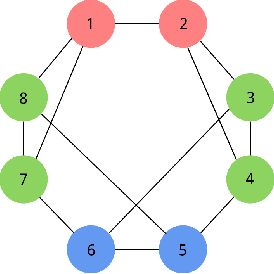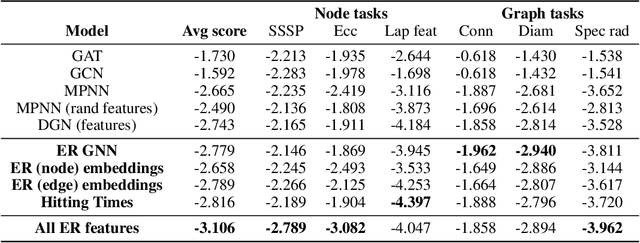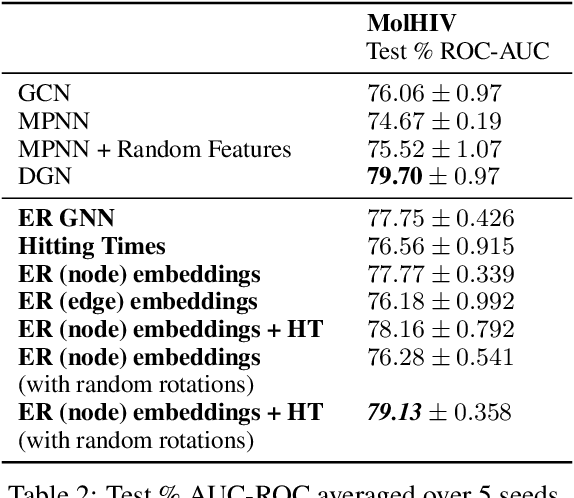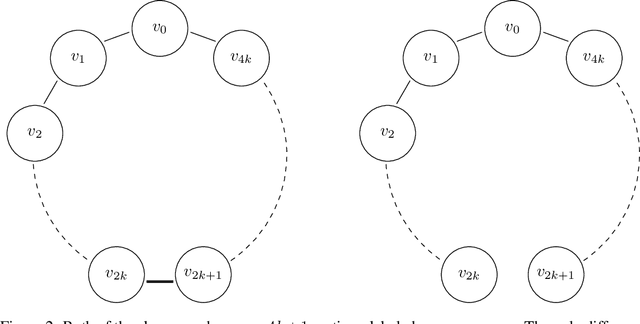Sreenivas Gollapudi
Combinatorial Optimization via LLM-driven Iterated Fine-tuning
Mar 10, 2025



Abstract:We present a novel way to integrate flexible, context-dependent constraints into combinatorial optimization by leveraging Large Language Models (LLMs) alongside traditional algorithms. Although LLMs excel at interpreting nuanced, locally specified requirements, they struggle with enforcing global combinatorial feasibility. To bridge this gap, we propose an iterated fine-tuning framework where algorithmic feedback progressively refines the LLM's output distribution. Interpreting this as simulated annealing, we introduce a formal model based on a "coarse learnability" assumption, providing sample complexity bounds for convergence. Empirical evaluations on scheduling, graph connectivity, and clustering tasks demonstrate that our framework balances the flexibility of locally expressed constraints with rigorous global optimization more effectively compared to baseline sampling methods. Our results highlight a promising direction for hybrid AI-driven combinatorial reasoning.
Sample, Scrutinize and Scale: Effective Inference-Time Search by Scaling Verification
Feb 03, 2025Abstract:Sampling-based search, a simple paradigm for utilizing test-time compute, involves generating multiple candidate responses and selecting the best one -- typically by verifying each response for correctness. In this paper, we study the scaling trends governing sampling-based search. Among our findings is that simply scaling up a minimalist implementation that uses only random sampling and direct self-verification results in sustained performance improvements that, for example, elevate the Gemini v1.5 Pro model's reasoning capabilities past that of o1-Preview on popular benchmarks. We partially attribute the scalability of sampling-based search to a phenomenon of implicit scaling, where sampling a larger pool of responses in turn improves verification accuracy. We further identify two useful principles for improving self-verification capabilities with test-time compute: (1) comparing across responses provides helpful signals about the locations of errors and hallucinations, and (2) different model output styles are useful for different contexts -- chains of thought are useful for reasoning but harder to verify. We also find that, though accurate verification can be elicited, frontier models demonstrate remarkably weak out-of-box verification capabilities and introduce a benchmark to measure progress on these deficiencies.
ReMI: A Dataset for Reasoning with Multiple Images
Jun 13, 2024



Abstract:With the continuous advancement of large language models (LLMs), it is essential to create new benchmarks to effectively evaluate their expanding capabilities and identify areas for improvement. This work focuses on multi-image reasoning, an emerging capability in state-of-the-art LLMs. We introduce ReMI, a dataset designed to assess LLMs' ability to Reason with Multiple Images. This dataset encompasses a diverse range of tasks, spanning various reasoning domains such as math, physics, logic, code, table/chart understanding, and spatial and temporal reasoning. It also covers a broad spectrum of characteristics found in multi-image reasoning scenarios. We have benchmarked several cutting-edge LLMs using ReMI and found a substantial gap between their performance and human-level proficiency. This highlights the challenges in multi-image reasoning and the need for further research. Our analysis also reveals the strengths and weaknesses of different models, shedding light on the types of reasoning that are currently attainable and areas where future models require improvement. To foster further research in this area, we are releasing ReMI publicly: https://huggingface.co/datasets/mehrankazemi/ReMI.
When Are Two Lists Better than One?: Benefits and Harms in Joint Decision-making
Sep 13, 2023Abstract:Historically, much of machine learning research has focused on the performance of the algorithm alone, but recently more attention has been focused on optimizing joint human-algorithm performance. Here, we analyze a specific type of human-algorithm collaboration where the algorithm has access to a set of $n$ items, and presents a subset of size $k$ to the human, who selects a final item from among those $k$. This scenario could model content recommendation, route planning, or any type of labeling task. Because both the human and algorithm have imperfect, noisy information about the true ordering of items, the key question is: which value of $k$ maximizes the probability that the best item will be ultimately selected? For $k=1$, performance is optimized by the algorithm acting alone, and for $k=n$ it is optimized by the human acting alone. Surprisingly, we show that for multiple of noise models, it is optimal to set $k \in [2, n-1]$ - that is, there are strict benefits to collaborating, even when the human and algorithm have equal accuracy separately. We demonstrate this theoretically for the Mallows model and experimentally for the Random Utilities models of noisy permutations. However, we show this pattern is reversed when the human is anchored on the algorithm's presented ordering - the joint system always has strictly worse performance. We extend these results to the case where the human and algorithm differ in their accuracy levels, showing that there always exist regimes where a more accurate agent would strictly benefit from collaborating with a less accurate one, but these regimes are asymmetric between the human and the algorithm's accuracy.
Congested Bandits: Optimal Routing via Short-term Resets
Jan 23, 2023

Abstract:For traffic routing platforms, the choice of which route to recommend to a user depends on the congestion on these routes -- indeed, an individual's utility depends on the number of people using the recommended route at that instance. Motivated by this, we introduce the problem of Congested Bandits where each arm's reward is allowed to depend on the number of times it was played in the past $\Delta$ timesteps. This dependence on past history of actions leads to a dynamical system where an algorithm's present choices also affect its future pay-offs, and requires an algorithm to plan for this. We study the congestion aware formulation in the multi-armed bandit (MAB) setup and in the contextual bandit setup with linear rewards. For the multi-armed setup, we propose a UCB style algorithm and show that its policy regret scales as $\tilde{O}(\sqrt{K \Delta T})$. For the linear contextual bandit setup, our algorithm, based on an iterative least squares planner, achieves policy regret $\tilde{O}(\sqrt{dT} + \Delta)$. From an experimental standpoint, we corroborate the no-regret properties of our algorithms via a simulation study.
Online Learning and Bandits with Queried Hints
Nov 04, 2022Abstract:We consider the classic online learning and stochastic multi-armed bandit (MAB) problems, when at each step, the online policy can probe and find out which of a small number ($k$) of choices has better reward (or loss) before making its choice. In this model, we derive algorithms whose regret bounds have exponentially better dependence on the time horizon compared to the classic regret bounds. In particular, we show that probing with $k=2$ suffices to achieve time-independent regret bounds for online linear and convex optimization. The same number of probes improve the regret bound of stochastic MAB with independent arms from $O(\sqrt{nT})$ to $O(n^2 \log T)$, where $n$ is the number of arms and $T$ is the horizon length. For stochastic MAB, we also consider a stronger model where a probe reveals the reward values of the probed arms, and show that in this case, $k=3$ probes suffice to achieve parameter-independent constant regret, $O(n^2)$. Such regret bounds cannot be achieved even with full feedback after the play, showcasing the power of limited ``advice'' via probing before making the play. We also present extensions to the setting where the hints can be imperfect, and to the case of stochastic MAB where the rewards of the arms can be correlated.
Affinity-Aware Graph Networks
Jun 23, 2022



Abstract:Graph Neural Networks (GNNs) have emerged as a powerful technique for learning on relational data. Owing to the relatively limited number of message passing steps they perform -- and hence a smaller receptive field -- there has been significant interest in improving their expressivity by incorporating structural aspects of the underlying graph. In this paper, we explore the use of affinity measures as features in graph neural networks, in particular measures arising from random walks, including effective resistance, hitting and commute times. We propose message passing networks based on these features and evaluate their performance on a variety of node and graph property prediction tasks. Our architecture has lower computational complexity, while our features are invariant to the permutations of the underlying graph. The measures we compute allow the network to exploit the connectivity properties of the graph, thereby allowing us to outperform relevant benchmarks for a wide variety of tasks, often with significantly fewer message passing steps. On one of the largest publicly available graph regression datasets, OGB-LSC-PCQM4Mv1, we obtain the best known single-model validation MAE at the time of writing.
Contextual Recommendations and Low-Regret Cutting-Plane Algorithms
Jun 09, 2021Abstract:We consider the following variant of contextual linear bandits motivated by routing applications in navigational engines and recommendation systems. We wish to learn a hidden $d$-dimensional value $w^*$. Every round, we are presented with a subset $\mathcal{X}_t \subseteq \mathbb{R}^d$ of possible actions. If we choose (i.e. recommend to the user) action $x_t$, we obtain utility $\langle x_t, w^* \rangle$ but only learn the identity of the best action $\arg\max_{x \in \mathcal{X}_t} \langle x, w^* \rangle$. We design algorithms for this problem which achieve regret $O(d\log T)$ and $\exp(O(d \log d))$. To accomplish this, we design novel cutting-plane algorithms with low "regret" -- the total distance between the true point $w^*$ and the hyperplanes the separation oracle returns. We also consider the variant where we are allowed to provide a list of several recommendations. In this variant, we give an algorithm with $O(d^2 \log d)$ regret and list size $\mathrm{poly}(d)$. Finally, we construct nearly tight algorithms for a weaker variant of this problem where the learner only learns the identity of an action that is better than the recommendation. Our results rely on new algorithmic techniques in convex geometry (including a variant of Steiner's formula for the centroid of a convex set) which may be of independent interest.
On the Learnability of Deep Random Networks
Apr 08, 2019

Abstract:In this paper we study the learnability of deep random networks from both theoretical and practical points of view. On the theoretical front, we show that the learnability of random deep networks with sign activation drops exponentially with its depth. On the practical front, we find that the learnability drops sharply with depth even with the state-of-the-art training methods, suggesting that our stylized theoretical results are closer to reality.
Ranked bandits in metric spaces: learning optimally diverse rankings over large document collections
Sep 01, 2012

Abstract:Most learning to rank research has assumed that the utility of different documents is independent, which results in learned ranking functions that return redundant results. The few approaches that avoid this have rather unsatisfyingly lacked theoretical foundations, or do not scale. We present a learning-to-rank formulation that optimizes the fraction of satisfied users, with several scalable algorithms that explicitly takes document similarity and ranking context into account. Our formulation is a non-trivial common generalization of two multi-armed bandit models from the literature: "ranked bandits" (Radlinski et al., ICML 2008) and "Lipschitz bandits" (Kleinberg et al., STOC 2008). We present theoretical justifications for this approach, as well as a near-optimal algorithm. Our evaluation adds optimizations that improve empirical performance, and shows that our algorithms learn orders of magnitude more quickly than previous approaches.
 Add to Chrome
Add to Chrome Add to Firefox
Add to Firefox Add to Edge
Add to Edge